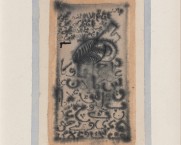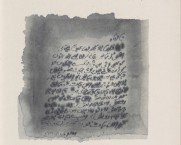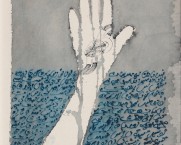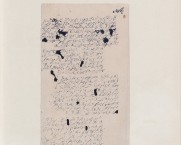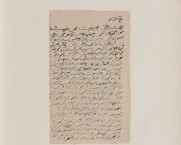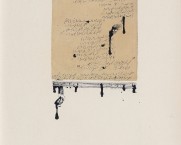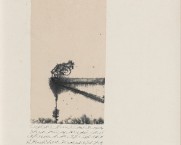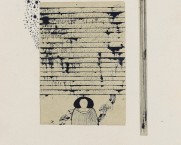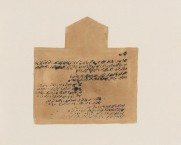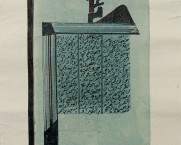Other Shows
Nafas (the Isolation Diaries) | blueprint.12
Arshi Irshad Ahmadzai
2021
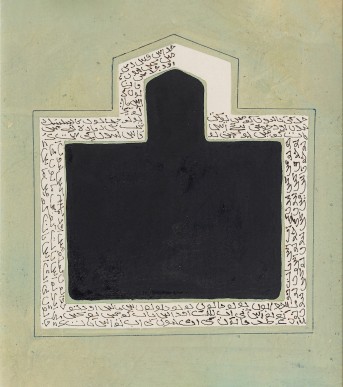
Overview
Nafas or The Isolation Diaries began in March 2020 when the world went into ‘lockdown’ due to the global pandemic of the virus which came to be known as COVID-19. Like any virus it is tasteless, invisible and odourless yet it remains to us as a potential silent killer, devastating lives and ripping families apart. In order to protect further damage each government of each country, one by one, locked their doors, closed their borders and ordered people to stay at home to ‘stay safe’. Yet staying at home came at the cost of forced separations from our loved ones with spiralling thoughts of isolation, sadness, anger and frustration.
For Arshi Irshad Ahmadzai this period resulted in 120 letters written to her husband, becoming artworks on cloth, all pages from a type of diary, completed over ten months. From the very beginning in March, Ahmadzai prepared her studio (an emptied room in her parents’ home) by writing script on the walls. These letters and words, pouring from her heart and down the walls came to bear witness on all that she did, all that she felt, acting as The First Letter. And as each month slipped by slowly, the practice of going to the studio, sitting on a prayer mat and intuitively recording her thoughts and reflections became a daily ritual in her private world. This was the only way to make sense of this unprecedented, uncertain and difficult time, a way of coping when all our routines were suddenly stopped.
Each work reveals a deep sense of contemplation of the self, of nature and existence. On a basic, biological construction we are all products of the choices our ancestors made. Without them, none of us would be here on this earth, living this life. To emphasize this point, Ahmadzai employs the motif of the abstracted heart, a stylised, anatomical drawing which perches quietly on the edges, at the corner or sometimes even in the centre of the ‘page’. By far the most powerful muscle in the human body, the heart is quite literally the lifeblood of all components of our physical presence.
Yet on another level, we see the heart is also symbolic of love and pain. Ahmadzai situates the heart as a vessel, a container for our hopes, wishes and desires. When we think with our hearts we think from a place of feeling, of deep-rooted instinct. How have our hearts brought us to this place? And how have the hearts of our ancestors brought us to this moment? Why are we here? Why do we exist in this moment of time?
Other repeating motifs include takhtis, the faceless female body, a hand, eyes, an empty chair and a cut-open pomegranate. The takhti, known as a slate or board used for practicing calligraphy, takes on an architectural dimension, like a mirror confronting us with lessons that we should learn. Sometimes, the boundaries of the takhti are blurred, washed away with rainwater, underlining how quickly lessons can become undone, once learned. The takhti speaks to the power of knowledge we acquire as we try to navigate our lives. An iconic symbol, familiar to the artist from her childhood days, the takhti is memorialised as a tombstone before us.
The faceless female body speaks of conformity, regulated in dress and hairstyle. Without a face, this figurative form cannot see, hear, smell or touch anything. Denied of sensuous pleasure, always standing as if searching and waiting for something more. The empty chair and the empty bed speak of the absent body and domestic space women are expected to inhabit, perhaps with a residue of warmth from the bodies that once occupied them? The bright red pomegranate fleshy seeds bring to mind the sexual body, but we wonder how or what caused it to be prised open and to lay there in its raw and exposed way?
As the months rolled on, from March through to December 2020, we see how the artist uses Urdu script, from right to left, as a gesture of mark making. Skimming across the pages of cloth, the words have been written with a Qalam (a bamboo reed pen), allowing the ink to soak into the fabric, letting it stain, drip and bleed on and through the yarns, blurring the words to such an extent, at times the words become obscure and we only see a dark puddle. This is no accident. It is a deliberate act. As if the words are crying in pain. At times, the pain is so great that there are no words. Only emptiness, a void, a sensation of loss. The words and letters float, becoming detached from their original meaning. At other times, there is so much to say, and the words are hurried along in an urgent manner, flattened between narrow ruled lines, cascading down the cloth but always contained within the page.
Indeed, the ruled lines punctuate the cloth-pages, attempting a regular rhythm but instead these lines fight for space on the page, having to justify their presence.Ahmadzai uses manjarpat a hard-wearing cotton cloth to create these works. In the artist’s Persian-Afghani-Indian culture, cloth has always played an intimate role in defining the female space. Some of her earliest memories are of the women in her family stitching and embroidering textiles in preparation for the wedding, part of a bride’s personal trousseau.
Indeed, cloth is an everyday material, employed by everyone in some capacity, a material we are all familiar with which predates and outlives our own existence. Whether we are wearing it, laying on it, holding a hot pan with it, or decorating our homes and religious spaces with it, cloth is our second skin. From the moment we are born to the moment we die, cloth wraps our bodies, protects our skin, heals our wounds, gives us warmth and shelter and carries our identity. Made by many hands and harvested from the land, it is magically manipulated on the loom. The warp yarns running parallel from north to south and the weft yarns interlacing from east to west form a three-dimensional grid-like structure which holds a multi-dimensional concept of space and time, infused with the spiritual and emotional past, present and future.
This cloth that we see in these works has gone through a slow and careful process of preparation. First, the pieces of cloth are left out to encounter the rain, absorbing the thumps and splashes of the raindrops of home, laid flat on the terrace. Tip. Tip. Tip. As each drop falls from the clouds in the sky above the cloth catches them, cushioning the sound and rhythms of the rain. After they have dried, they are cut into smaller pieces and some of the cloth then goes through a further transformation, soaking up hand-made dyes made from flowers such as roses and carnations, plucked from her mother’s garden and soaked in water to capture some of their vibrant colours. Now, each page carries a unique texture, scent and combination of subtle colours. For Ahmadzai this process of preparing the cloth is as much part of the artwork as embellishing it with visual codes of script, lines and motifs. Through this process, the cloth becomes the sacred space holding the communion between the artist and all the natural elements, taking on a sensuous pleasure, moving beyond its everydayness. When we see and touch these works, we see and touch part of the artist’s inner & outer worlds.
– Uthra Rajgopal, Independent Curator with a specialist interest in South Asian textiles & textile arts

